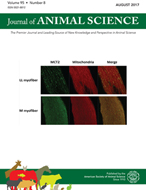-
Views
-
Cite
Cite
J. T. Yen, V. H. Varel, J. A. Nienaber, Metabolic and microbial responses in western crossbred and Meishan growing pigs fed a high-fiber diet, Journal of Animal Science, Volume 82, Issue 6, June 2004, Pages 1740–1755, https://doi.org/10.2527/2004.8261740x
Close - Share Icon Share
ABSTRACT
Four Duroc × White composite crossbred (21.8 ± 1.0 kg BW) and four 12-wk-old Meishan purebred (20.7 ± 1.6 kg BW) growing barrows were used to determine the relative breed differences in metabolic and microbial responses to a high-fiber diet. The pigs were trained to consume 700 g of a diet containing 35% (as-fed basis) dehydrated alfalfa meal once daily. The pigs' daily intakes of DM, N, GE, NDF, and ADF were 610 g, 16.6 g, 2.64 Mcal, 150 g, and 88 g, respectively. On d 12 after surgical catheterization of the portal vein, ileal vein, and carotid artery, a 3-d total urine and feces collection was conducted. On d 24 after surgery, each pig was placed in an open-circuit calorimeter, and its catheters were connected to a system for simultaneous measurements of oxygen consumption by portal-drained viscera and by whole body, and the net portal absorption of VFA after a 24-h fasting and during a 5-h postprandial period. The VFA measured included acetic, propionic, isobutyric, butyric, isovaleric, and valeric acids. A second 3-d total urine and feces collection was conducted on d 30 after surgery. There were no differences (P = 0.13) between the first and second collections in apparent total-tract digestibility coefficients for nutrients and N retention of pigs. Compared with Duroc × White composite crossbred pigs, Meishan pigs had lower (P = 0.05) apparent digestibility coefficients for DM, N, NDF, hemicellulose, and N retention, but their portal-drained viscera used a greater (P = 0.05) fraction of whole-body oxygen consumption. No differences (P = 0.12) were found between Duroc × White composite crossbred and Meishan pigs in total viable bacteria and cellulolytic bacteria from fecal samples, in vitro digestibility of alfalfa NDF fractions by fecal inocula, whole-body oxygen consumption, net portal absorption of VFA, total energy of absorbed VFA, and the potential of absorbed VFA for meeting the energy needs for whole-body heat production. These results indicate that, in contrast to previous beliefs, the ability of Meishan growing pigs to utilize a high-fiber diet is not superior to that of Duroc × White composite crossbred growing pigs.





